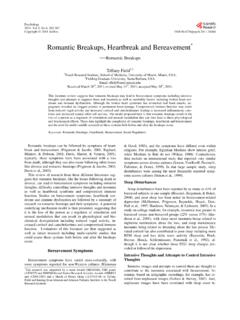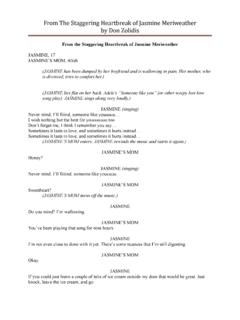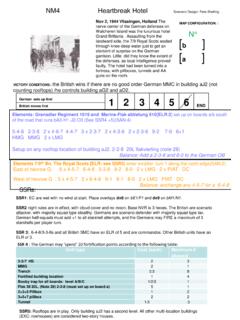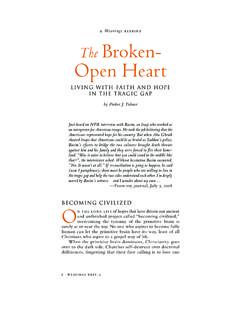Transcription of “Heartbreak Highway” The Cross-Bronx Expressway - MIT
1 heartbreak Highway The Cross-Bronx Expressway Steve Alpert Final Project Spring 2003 The Cross-Bronx Expressway , one of the last freeways to be completed in New York City, represents the end of an era. Socially, it marked the last time a neighborhood would be torn apart while ignoring the voices of the people living there. Politically, it marked the end of Robert Moses career as head of the Triborough Bridge and Tunnel Authority (TBTA). No planned freeway has been built in New York City since the completion of the Cross-Bronx (the Bruckner Expressway was already under construction), and the Cross-Bronx cannot reasonably be widened or rerouted.
2 In short, the twenty years of heavy Expressway construction following World War II came to a head with one of the most notorious highways still standing. After looking at a history of freeways in New York City and the development of the concept of a freeway crossing the heavily developed bronx borough, this paper will go into the justification for the project, analyzing risks, potential costs, and potential benefits. Then, as the project unfolds, this paper will examine the social, political, and other construction problems Moses faced while still in charge of the TBTA, analyzing the costs they introduced. After sections on the Highbridge and Bruckner Interchanges, which cap the freeway on the west and east ends respectively, this paper concludes with a look at the effects of the Cross-Bronx , both local and national, and the state of the freeway today.
3 History New York, in particular the New York City area, had been a pioneer in highway construction since the advent of the automobile. In 1908, William K. Vanderbilt, a racing fanatic who had already led races along local Long Island Streets, opened the Long Island Motor Parkway (LIMP) as a racecourse that could be used as a public highway, for a fee. Minus the tolls, which disappeared with the Parkway in April 1938, the concept of the New York parkway was introduced a high-speed, limited-access roadway with few if any grade crossings and prohibited to commercial traffic. While this first freeway was a private venture, once Robert Moses became Parks Commissioner of both the New York State and Long Island commissions in 1924, parkways became state ventures and thus were untolled.
4 The debut of the modern parkway system came just one year after that appointment, with the opening of the bronx River Parkway in 1925. Although there were some grade intersections, a few of which are still present, it remained true to the original LIMP in having completely controlled access in other words, there were few public and no private access points along the road. The Northern State Parkway, which caused the demise of the antiquated LIMP, opened in 1938, at which point the parkway system was quite developed. By 1945, when the Expressway system was first proposed for all vehicles (because no commercial vehicles were allowed on any parkway), the parkways had formed an extensive network [right].
5 After Robert Moses became head of the New York City Parks Commission and the TBTA in 1933, he spent many years building necessary tunnel and bridge links; very few have since been constructed. Thus when the Regional Plan Association proposed to add expressways to the parkway network in December 1936, nothing more than proposals, such as the dashed lines on the above map, came to be. After World War II, though, Moses was ready to build, and in late 1945 he proposed over 100 miles of new Expressway construction, more than had yet been proposed anywhere else in the country. Many of these roads could be found on the earlier RPA proposal, yet Moses today receives the credit for the original concept.
6 Just before the United States joined World War II, the New York City Planning Department reviewed the RPA proposal and made recommendations as to which expressways should be constructed. Among these was the bronx Crosstown Highway, projected to cross difficult terrain and heavily built-up areas. Despite the significant topological challenge and the costs of displacing people and acquiring land, the 1941 estimate of the Cross-Bronx Expressway cost was just $17 million, or just under $28 million in 1950 dollars. The planned Expressway would connect with seven other freeways, cross 113 streets and six subway lines (five elevated), and three rail lines [source: ].
7 It would have to be carved out rock for much of the route, and then get across lowlands in the middle. As it was originally planned, it would tie into the Washington Bridge, a four-lane crossing from the bronx to Manhattan built in 1888, and the Bruckner Circle, at that time the meeting point for Bruckner Boulevard and the Hutchinson River Parkway. While the improvement of the circle would wait for the much-delayed Bruckner Expressway through southern bronx , the Washington Bridge was upgraded almost immediately. Bids were let in 1949 to remove trolley tracks, narrow sidewalks, and widen the bridge to allow six lanes of travel with a median. Although the bridge would still have a traffic light on the bronx side, the Interstate system had not yet been proposed, so there was no perceived need to bypass it.
8 Other preliminary work included tying the proposed Expressway to the George Washington Bridge on the far side of Manhattan, at the time still only a single span (it would be double-decked in 1962 for the opening of the Cross-Bronx ). The Port Authority of New York and New Jersey at the time sat on top of a two-lane tunnel that linked the bridge to the east side of Manhattan; they let almost $7 million of contracts to build a new, parallel tunnel concurrently with Washington Bridge construction. In addition, the Highbridge interchange linking the Washington Bridge and the Port Authority tunnel underwent initial improvements from 1949 to 1952.
9 Risks and Uncertainties The first part of this section concerns the risks and uncertainties that were faced heading into the project; the second part deals with sensitivity analyses for selected scenarios ( how sensitive overall project cost is if a certain scenario plays out). A big uncertainty heading into any project is time. The Cross-Bronx Expressway was proposed at the same time as the rest of the New York City area Expressway network, and was expected to be completed in at most ten years. While some of the other parts of the highway system were not built until the 1960 s, such as the Verrazano Narrows Bridge and Bruckner Expressway , the Cross-Bronx had by far the longest duration of construction of any of the projects.
10 One of the major factors that delayed the Expressway was overcoming community opposition and relocation people; materials availability was another problem. Nevertheless, the projected completion time in 1954 was four years (the actual time was twice that). Another uncertainty is the effect of community opposition. Even in the 1941 proposal from the city s planning department, difficulties due to existing development were foreseen. However, the social and political ramifications of the contested routing, to be discussed later, were unprecedented for any project, and set a tone of opposition for future projects. This uncertainty leads to the risk that after building some sections of the highway, other sections will be proposed but never built.



















